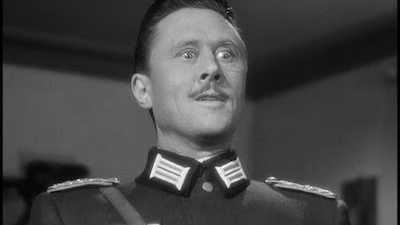Joan Bennett

About
Biography
Filmography
Family & Companions
Bibliography
Notes
"I don't think much of most of the films I made. But being a movie star was something I liked very much." --Joan Bennett in 1986. (NEW YORK POST, December 10, 1990)
"If it happened today, I'd be a sensation. I'd be wanted by all studios for all pictures." --Joan Bennett in a 1981, discussing the 1951 scandal (NEW YORK TIMES obituary, December 9, 1990
Biography
Personable, extremely pretty and prolific star of a wide range of films in the 1930s and 40s. Bennett began her film career as a demure blonde ingenue (e.g. in George Cukor's "Little Women" 1933, William K. Howard's breathtaking "The Trial of Vivienne Ware" 1932). Raoul Walsh's delightful "Me and My Gal" (1932), though, did give her an offbeat chance to indulge in sharp wisecracking. Early on her acting abilities seemed a bit modest, but Bennett's warm speaking voice and quietly piquant charm gave her considerable appeal as a screen personality.
Gregory LaCava's pioneering study of mental health problems, "Private Worlds" (1935), gave Bennett an unusually good acting opportunity, and the sensitivity and vulnerability she brought to the role showed the increasing resonance she was bringing to her screen work. If she never did possess the acting bravura of Hollywood's most intense dramatic divas, Joan Bennett was nonetheless intriguing, likable and highly watchable, her sometimes aloof, serene presence highly effective at suggesting muffled passion. In 1938 she followed the trend of going brunette and parting one's hair in the middle (inspired by Hedy Lamarr's strong first Hollywood impression), and the look stuck. "Trade Winds" (1938) was an enjoyable Tay Garnett romp, and "The Housekeeper's Daughter" (1939) gave Bennett a good Hal Roach comedy, but she soon developed into a sultry, brunette fixture who proved outstanding in several 1940s films noirs. Sometimes sympathetic, sometimes a femme fatale, Bennett acted in a quartet of Fritz Lang thrillers, "Manhunt" (1941), "Woman in the Window" (1944), "Scarlet Street" (1945) and "Secret Beyond the Door" (1948), which represent some of her best work in film.
Bennett also appeared in a wide variety of other films during this time, ranging from the semi-musical period drama, "Nob Hill" (1945) to the interesting Hemingway adaptation "The Macomber Affair" (1947), which traded in on her more seductive noir roles. As middle age approached, Bennett shifted to the role of witty and nurturing mother in Vincente Minnelli's comedies "Father of the Bride" (1950) and "Father's Little Dividend" (1951). She was also especially fine as a mother whose family is jeopardized in Max Ophuls's unusual noir, "The Reckless Moment" (1949).
Her career was short-circuited in 1951 after her husband, producer Walter Wanger, shot her agent, Jennings Lang, accusing the latter of being a "homewrecker." She was offered few film roles after that (Douglas Sirk's "There's Always Tomorrow" 1956, in which she supported Barbara Stanwyck and Fred MacMurray), though she returned to the stage in several national tours. Later in life Bennett could be seen in a leading role on TV on the highly enjoyable cult Gothic soap opera, "Dark Shadows" (1966-71) and her last film appearance was in Dario Argento's cult horror film, "Suspiria" (1976).
Daughter of famed stage (and occasionally screen) actor Richard Bennett, sister of fellow film star Constance Bennett, and also sister of actress Barbara Bennett; she was married to Wanger (her second husband) from 1940 to 1965.
Filmography
Cast (Feature Film)
Film Production - Main (Feature Film)
Cast (Special)
Cast (Short)
Life Events
1915
Had a bit part in father Richard Bennett's medium-length film, "The Valley of Decision"
1928
Stage debut (with father) in "Jarnegan"
1928
Film acting debut in "Power"
1929
First major film performance in "Bulldog Drummond"
1938
Became a brunette, adopting a "Hedy Lamarr look" for the film "Trade Winds," at suggestion of producer Walter Wanger; kept her hair dark for the rest of her career
1941
First film with director Fritz Lang, "Man Hunt"
1951
Involved in Hollywood scandal when then-husband producer Walter Wanger, shot and wounded her agent, Jennings Lang, in a Los Angeles parking lot
1954
Returned to films after a three-year absence to act in "Highway Dragnet"
1966
TV soap opera debut as Elizabeth Collins Stoddard on "Dark Shadows"; also acted in a feature film based on the series, "House of Dark Shadows" (1970)
1976
Last film, "Suspiria"
Photo Collections
Videos
Movie Clip












Trailer







Promo
Family
Companions

Bibliography
Notes
"I don't think much of most of the films I made. But being a movie star was something I liked very much." --Joan Bennett in 1986. (NEW YORK POST, December 10, 1990)
"If it happened today, I'd be a sensation. I'd be wanted by all studios for all pictures." --Joan Bennett in a 1981, discussing the 1951 scandal (NEW YORK TIMES obituary, December 9, 1990
A contemporary verse when Joan Bennett turned brunette went, "Let's sing of Lamarr, that Hedy so fair/Is it true that Joan Bennett wears all her old hair?"












